
By Brett Gonzalez, Field Technician - Marine Biospeleology Lab Texas A&M University at Galveston
and Nic Alvarado, Expedition Coordinator - NOAA's Office of Ocean Exploration and Research
June 22, 2011
Successful scientific diving projects require specialized equipment and thorough planning. A key component is the expert safety divers. The roles and responsibility of the Safety Divers were vital to the safe success of the Bermuda Deep Water Caves Project.
So you want to be a safety diver on a high profile diving research project?
Join the Iliffe dive team as they explore the Bermuda shelf edge to confirm the existence of once dry now submerged deep-water caves and collect unique biology. Video courtesy of Bermuda Deep Water Caves, NOAA-OER. Download (mp4, 14.4 MB).
Prior to each day of science diving, the safety divers were debriefed by the project Diving Safety Officer (DSO). Due to the complexity of the Bermuda Deep Caves Project, there were several different categories of safety divers, each with specific equipment specifications and depth ratings to ensure that regardless of dive mission, each person in the water diving was able to be returned to the diving platform. To better assist with communications between divers at depth and those at the surface, each diver carried both an orange and a yellow surface marker buoy to be deployed based on the type of problem. Orange signified a major equipment failure or medical issue and yellow to signify that all was well but ascent was being done away from the mooring line. The safety divers on site each day included a backup rebreather diver in the event of a problem at depths greater than 130 feet, an open circuit safety diver who was responsible for meeting the science team at 100 feet and escorting them throughout their remaining decompression schedule. In addition, the safety divers monitored dive computers, equipment, cylinder pressure and checked for any potential dangerous marine life. A surface support snorkeler was tasked with being a back up open circuit diver in the event of strong currents carrying the science team off the mooring line. They also assisted with setting up the decompression bar and helped the open circuit safety diver with transfer of collecting bags and scuba equipment placement and removal.
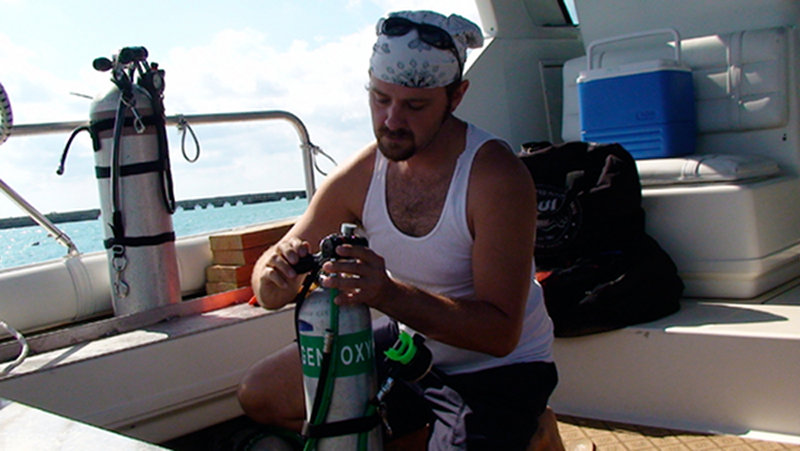
Brett Gonzalez checking the pressure of the oxygen deco tanks. Image courtesy of Bermuda Deep Water Caves 2011 Exploration, NOAA-OER. Download larger version (jpg, 2.4 MB).
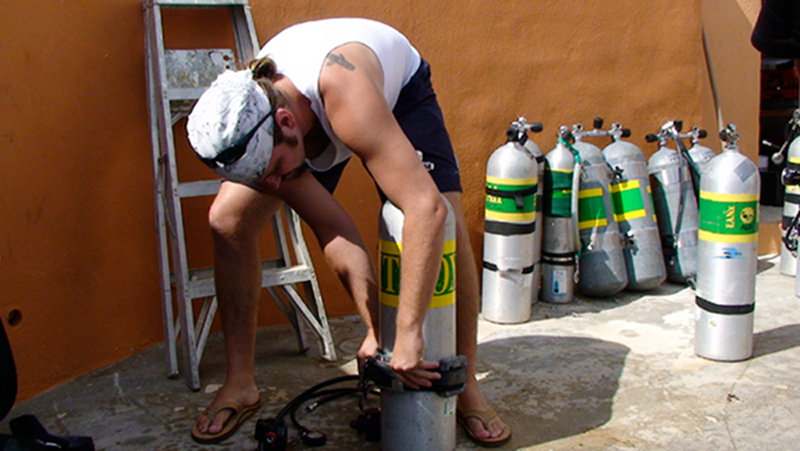
Brett Gonzalez preparing the rigging of Aluminum 80 deco bottle. Image courtesy of Bermuda Deep Water Caves 2011 Exploration, NOAA-OER. Download larger version (jpg, 2.7 MB).
The surface support snorkeler and the open circuit safety diver started off each day by assisting the science team with gas checks, equipment loading, and clipping off collection bags. Once the boat arrived at the dive site, they helped deploy the mooring anchor and attach the surface buoys. As the deep science team was gearing up, safety divers were preparing their bailout bottles which were to be clipped under each arm. Depending on the weather and sea state, this was done either on the deck of the boat or in the water. Communication was critical at this time as it was very important to accurately document water entry and descent times by either hand signals or verbal shouts. The commotion on deck was silenced and immediately focused on the safety diver as soon as “diver in the water” was called, signifying a science diver entered the water. Soon after “diver down” was shouted out, the science diver would descend to 15 feet to perform rebreather checks. Once the entire science team had performed all of their in water checks at 15 feet, they would start their mission and the observing safety diver would call out “divers descending, start the clock.” Every member of the safety team now was on high alert, scanning the horizon for marker buoys, bubbles, boats, and potential hazardous marine life.
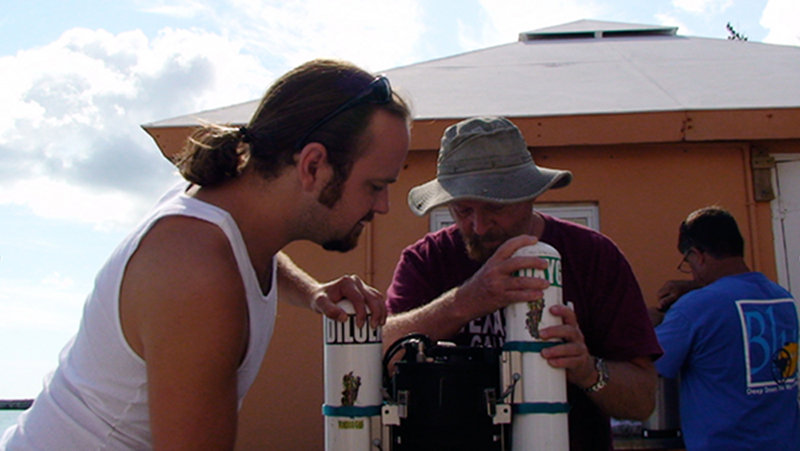
Brett Gonzalez assisting Tom to prep his rebreather. Image courtesy of Bermuda Deep Water Caves 2011 Exploration, NOAA-OER. Download larger version (jpg, 2.1 MB).
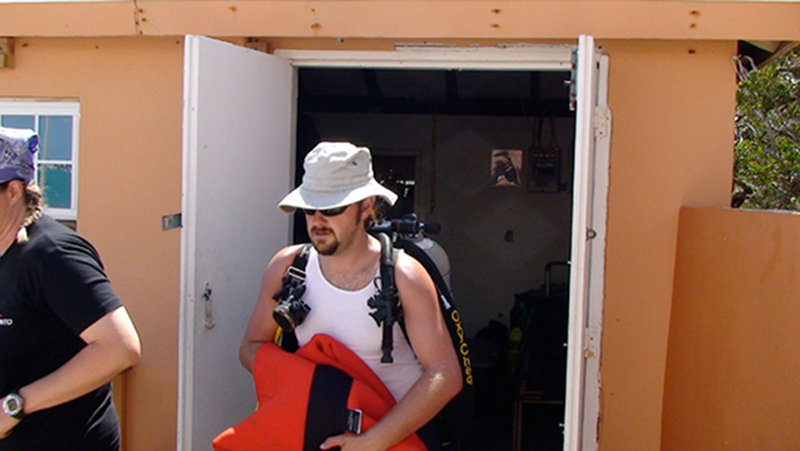
Brett carrying his double AL80s to the boat for his role as safety diver. Image courtesy of Bermuda Deep Water Caves 2011 Exploration, NOAA-OER. Download larger version (jpg, 2.6 MB).
Because of the short bottom times of the science team, the open circuit safety diver was required to have their entire gear ready prior to the start of the deep dives in the event of a problem during descent. This included back-mounted double tanks, a stage bottle, and an emergency oxygen bottle, in addition to surface marker buoys, and a predator deterrent stick. At the same time, the backup rebreather diver was also geared up in the event of an orange marker buoy being deployed; standing down only once the open circuit safety diver had descended. Monitoring dive time, which included the descent time, was crucial in order for the open circuit safety diver to accurately calculate entry time to meet the science rebreather divers at 100 feet. The open circuit safety diver s were restricted on depth to ensure that at any moment of our dive, we could immediately ascend without any decompression obligations in the event of an emergency.
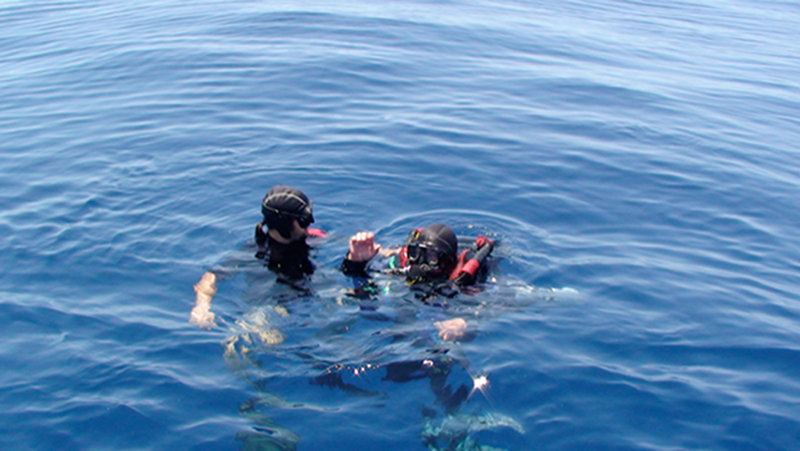
Brett lending Paul a hand placing deco tanks. Image courtesy of Bermuda Deep Water Caves 2011 Exploration, NOAA-OER. Download larger version (jpg, 2.5 MB).
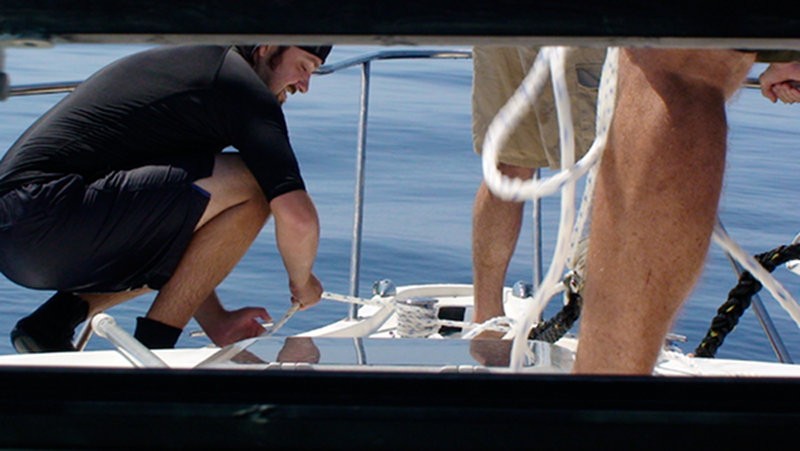
Brett acting as a deck hand recovering the anchor line. Image courtesy of Bermuda Deep Water Caves 2011 Exploration, NOAA-OER. Download larger version (jpg, 2.3 MB).
While the open circuit safety diver was monitoring the ascending science team, the surface snorkeler was setting up the rigging for the decompression bar and the specimen retrieval system. The decompression bar consisted of a solid 1.5 inch steel pipe with floats on either end that was attached to the mooring line at twenty-five feet, just below the science teams’ last decompression stop. Attached to the bar was also a 100 pound lift bag which could be used to raise collected specimens and equipment to the surface. Since the last of the required decompression stops could be upwards of an hour or more, the bar was crucial in order for all divers to have adequate room and proper hand holds in the event that weather or currents became problematic.
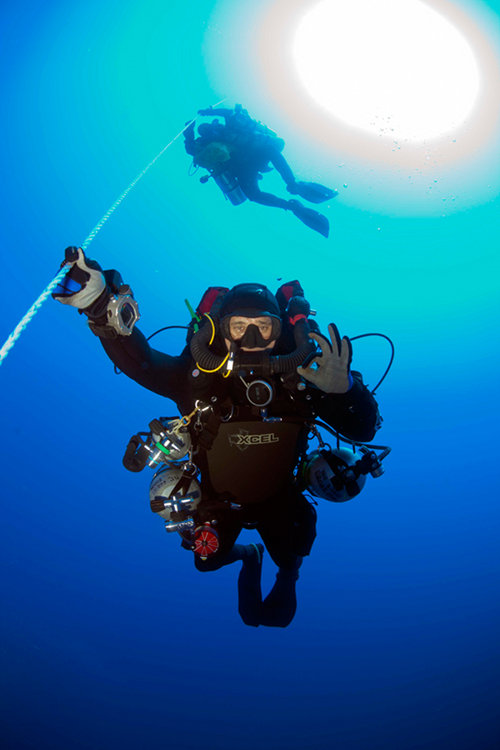
Nic Alvarado greeting Jill Heinerth at depth. Image courtesy of Jill Heinerth, Bermuda Deep Water Caves 2011 Exploration, NOAA-OER. Download larger version (jpg, 2.4 MB).
The final and most crucial task of the open circuit safety diver was at the conclusion of decompression to safely guide the science divers one at a time from the decompression bar back to the boat ladder. After long, deep, strenuous dives requiring long decompression, exerting yourself physically can lead to dive related medical issues. Therefore, the safety diver would often tow or assist in swimming the science team to the ladder where they would remove (with the assistance of the surface snorkeler) the bailout bottles, fins, and other gear. This same process would be repeated until all deep science divers were out of the water. The last task was to remove the decompression bar and exit the water. A sigh of relief is expressed by all on deck when the final call of “all divers up” is heard between the laughs and chit chat of the science divers.
Safety divers encountered total dive times of three hours, most of it spent at twenty-five feet, but the pay off of knowing that everyone returned safely and conducted good science was all that mattered. After more than two weeks of deep diving when the trip drew close to an end, I (Brett) joked with the science team that I have yet to see the ocean floor of Bermuda.
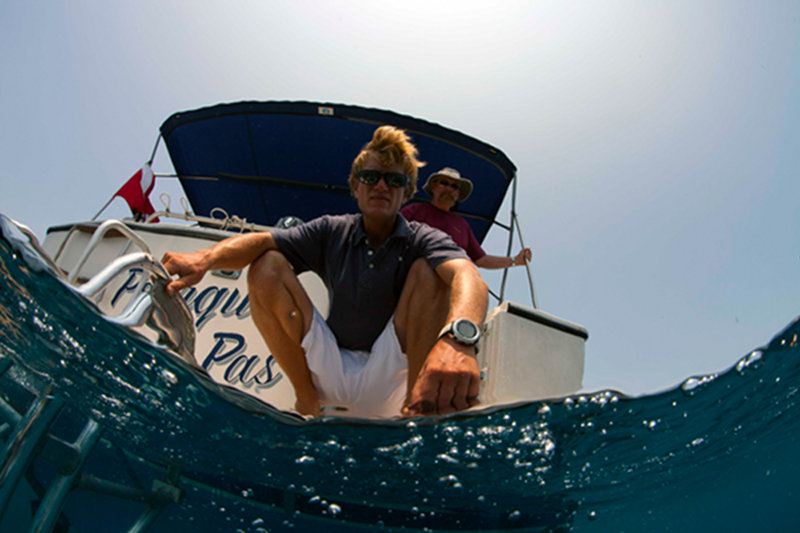
Ondrej Hindl and Tom Iliffe looking down on the diver as they reach the stern of the boat. Image courtesy of Jill Heinerth, Bermuda Deep Water Caves 2011 Exploration, NOAA-OER. Download larger version (jpg, 3.4 MB).
So this is what being a safety diver on a high profile diving research project is all about!